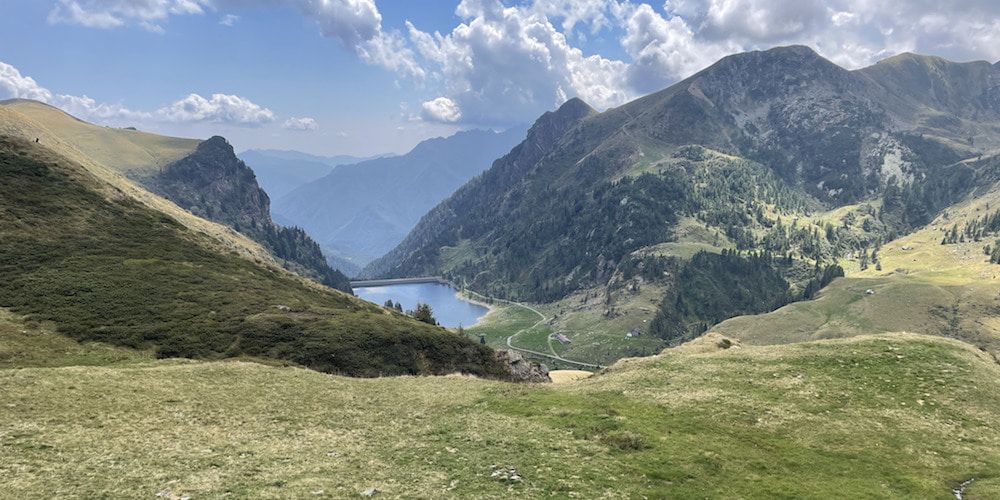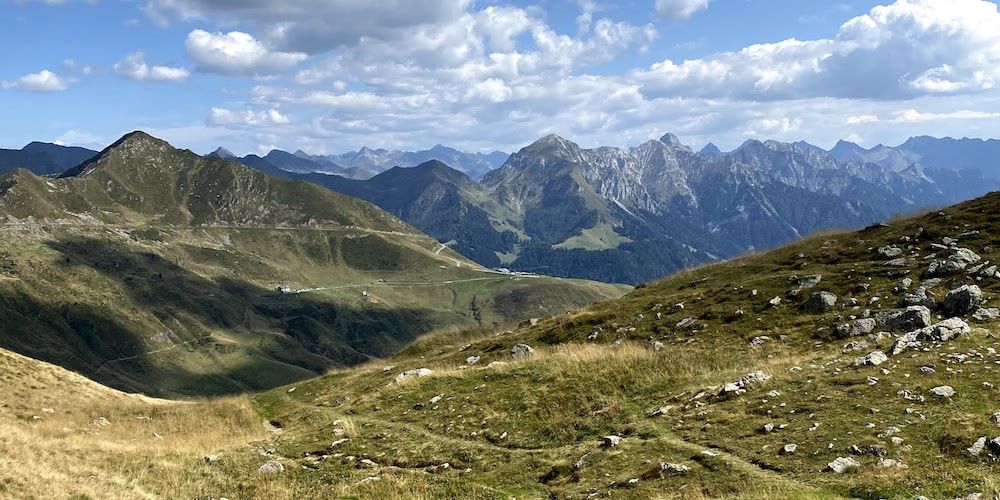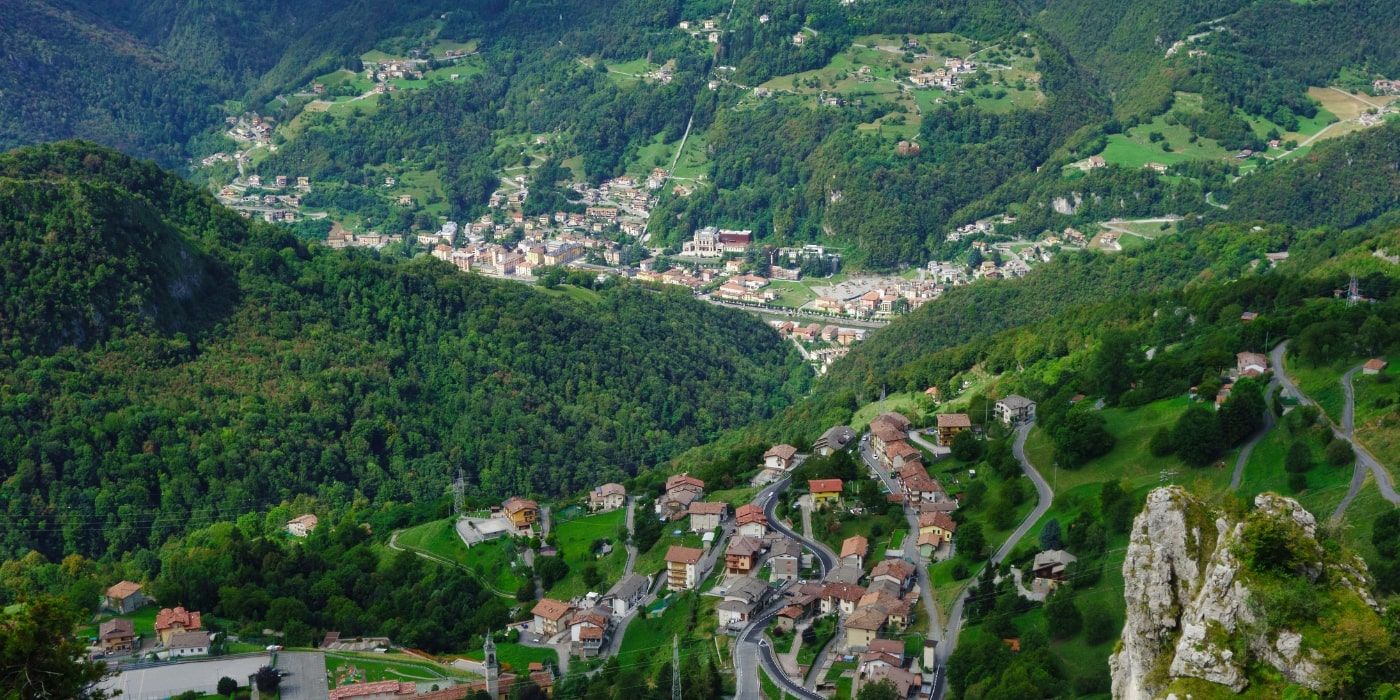Val Brembana is located in the province of Bergamo, set between the spectacular peaks of the Alpi Orobie and a heavily urbanized valley floor where the river Brembo flows quickly.
The mountain landscapes, the hiking opportunities on the many trails and the presence of picturesque villages and historical attractions make the entire valley a real paradise for mountain lovers and, in general, for all tourists who like to visit beautiful places surrounded by a natural setting of exceptional beauty.

Val Brembana, a journey through enchanting paths and historic hidden villages

View from San Marco Pass towards Val Brembana
In our itinerary to discover the Val Brembana, we will start from the outskirts of Bergamo, going up the valley and reaching the town of Zogno and the intersection with the Val Serina, an area full of beautiful hiking trails, particularly on the paths of the ancient Via Mercatorum.
Then we will arrive in the town of San Pellegrino Terme, the main center of Val Brembana, full of tourist attractions. Immediately north of San Pellegrino, we will meet the road that goes up to Dossena, with its mines and the Tibetan bridge, and after that we'll reach the historic village of Cornello dei Tasso, a real open-air museum.
Finally we will get to the upper valley by travelling parallel to the Val Brembana cycle route, concluding our journey at the 2000 meters of the San Marco Pass, where a path immersed in the most classic alpine nature will lead us to the historic trenches dating back to the First World War.
Towards San Pellegrino Terme, the beating heart of Val Brembana
From the very beginning of the valley, near Villa d'Almè, there are less than 15 km to arrive at San Pellegrino Terme. We get there after passing the villages of Sedrina, birthplace of the legendary cyclist Felice Gimondi, and Zogno.
San Pellegrino is famous all over the world for the homonymous mineral water and right here, in fact, is located also the S.Pellegrino company. The town is also an important thermal centre: the spa, born in the early '900 with the construction of beautiful buildings in Art Nouveau style, had lost relevance towards the end of the century, but has been completely renovated in 2014 and today it represents an excellence of this territory.
Other attractions of San Pellegrino Terme include:
- the Grand Hotel, a building with majestic and spectacular architecture located next to the river. It was built in 1904 and the following year Margherita di Savoia, Queen of Italy, stayed here. In later years, other characters such as Eugenio Montale and Salvatore Quasimodo resided in this hotel;
- the Casino, another characteristic building of the early '900, with a beautiful facade with two high towers and an interior with an atrium where we can find several columns in red Verona marble and a wonderful staircase in Carrara marble. Since 1917 the casino is no longer in business: today it hosts conferences or weddings, and can be visited during the summer;
- Tempio dei Caduti, originally called Tempio della Vittoria, is a war memorial. Built of local stone in 1924, contains inside magnificent mosaics representing scenes of war and biblical events.
San Pellegrino is the place to stay for visiting with daily excursions other areas of Val Brembana, such as the nearby Val Serina.
Accessible by passing the river Brembo at the junction of Ambria, between Zogno and San Pellegrino, Val Serina offers many opportunities for nature hikes, especially through the network of trails called via Mercatorum.
Via Mercatorum, as the name indicates, is a maze of trails developed already in medieval times to encourage trades between the city of Bergamo and the nearby mountain valleys. These routes are now well marked and have been developed in a tourist perspective. In fact, especially in summer, they are a destination for excursions and walks suitable for families, offering a beautiful scenery and outstanding views.
Now we go back to San Pellegrino Terme to spend the night: we can opt for the historic Hotel Bigio, perfect for its location right in the centre of the town; or for the QC room San Pellegrino, a modern lifestyle hotel just a few steps from the spa (the brand in fact is the same, QC Terme).
A visit to Dossena: the historical mines and the new Tibetan bridge
We leave San Pellegrino and continue our itinerary in the heart of Val Brembana. Driving just a few hundred meters outside the town, we met a road to the right that, after crossing the river, goes up towards the village of Dossena.
Dossena is located between Val Brembana and Val Serina: its historical mines, from which once was extracted calamine and, only recently, fluorite, are the main attraction of the town. Dossena was in fact an important mining center already in Roman times, and this activity continued almost uninterrupted until 1981.
Today there are 18 km of excavations, of which 2 km can be visited through very suggestive guided tours, in which we can take part with a helmet on our head to live an immersive and safe experience through the tunnels and ventilation chimneys, rails and old rusty carriages, and even an underground pond.
More recently, in 2022, Dossena also saw the inauguration of a Tibetan bridge called Ponte del Sole: the idea is to develop natural tourism through the creation of this enchanting bridge from which we can admire, not without some thrill, a breathtaking landscape.
The villages of Val Brembana: Cornello dei Tasso
From Dossena we descend again to the valley towards San Pellegrino. Once back on the Val Brembana state road, we continue north for a few kilometers until San Giovanni Bianco.
From here, turning left at the fork towards the end of the village, we can reach Val Taleggio, a little valley famous for its typical products including some types of cheese known all over the world. In fact, Val Brembana and the surrounding valleys represent a world-class dairy excellence, with products such as Taleggio, Branzi and Formai de Mut.
After San Giovanni Bianco we turn right, along the river in a small gorge until we reach the village of Camerata Cornello. From here starts one of the paths of the Via Mercatorum that, in a few hundred meters, reaches the picturesque village of Cornello dei Tasso.
Dating back to Middle Ages, Cornello dei Tasso owes his name to the presence in the village of the Tasso family, of which Torquato Tasso, famous writer and poet, author of the heroic poem Gerusalemme Liberata, was also part.
The remains of Palazzo Tasso are still visible today, along with the arcades and stone arches that characterize the small village, which today has become a sort of open-air museum, a window on the medieval history of the territory. The church in Romanesque style dominates from above the beautifully preserved village.
The path of the Via Mercatorum continues even after Cornello dei Tasso, entering a wood and reaching the nearby village of Oneta.
Oneta is another charming village where we can find the Casa Museo di Arlecchino, a noble palace that now houses numerous masks of characters of the comedy of art, and where in the past stayed, according to tradition, the Renaissance actor Alberto Naselli.
Alta Val Brembana and the San Marco Pass

Alpi Orobie from the San Marco Pass
After the village of Camerata Cornello, we go deeper into the upper valley. We continue parallel to the Ciclovia della Val Brembana, one of the most fascinating bike paths in Italy, which reaches Piazza Brembana following the old railway that once connected this town to Bergamo.
As we go past Olmo al Brembo, we begin to rise in altitude and the landscape becomes wilder and wilder. Mezzoldo is the last real village before the start of the climb towards the San Marco Pass, which divides Val Brembana from Valtellina.
From the Madonna delle Nevi lodge many hiking trails start, but even just continuing on the main road is a real show, thanks to the hairpin bends that look like windows opened onto a typical and fabulous high mountain panorama.
The top of the San Marco Pass is almost 2000 meters, but before the pass we can stop at the refuge of Ca' San Marco to refresh ourselves in an idyllic setting in the midst of boundless meadows and majestic surrounding peaks.
One of the paths that start from the refuge leads to the historic trenches of the First World War: it’s an excursion of a couple of hours (round trip) that combines natural beauty and the history of this territory. From the trenches you can enjoy amazing views of both Val Brembana and the underlying Lake Valmora, as well as the adjacent Valtellina.
And this is how our itinerary ends: after visiting the area of the San Marco Pass (better in the morning, because afternoon summer storms are not uncommon), we can return to San Pellegrino and spend the evening enjoying an ice cream, relaxing at the spa, or simply walking along the riverside and enjoying the magical and sparkling air that, from the high mountains to the villages of the valley floor, makes the experience of a trip to Val Brembana so special and astonishing.
About the author
Written on 29/06/2023



Alessandro Savino
Discover the natural and historical beauties of Val Brembana, in a perfect itinerary among villages, products of excellence and outdoor activities.